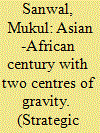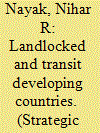| Srl | Item |
| 1 |
ID:
143842


|
|
|
|
|
| Summary/Abstract |
While China and the United States (US) have recognised the strategic significance of the re-emergence of Asia, India has yet to see itself as one of the two centres of gravity in Asia, as has been the case throughout civilisation, having close trade links with Africa.
|
|
|
|
|
|
|
|
|
|
|
|
|
|
|
|
| 2 |
ID:
143846


|
|
|
|
|
| Summary/Abstract |
There are multiple levels of relationship between India and Nepal. This article deals exclusively with their bilateral transit relations, focusing on their negotiations in the context of Nepal as a landlocked developing country (LLDC). While LLDCs consider their free access to the nearest seaport through a transit country as a natural right, the transit countries often bargain with them from a position of strength. The study reveals that while India used the transit issue as a political leverage, Nepal claimed it as its right to access the sea, undermining or without showing adequate sensitivity towards India’s security concerns. It is observed that Nepal did not benefit much from exporting to third countries due to both poor transit facilities in India and the absence of internationally acceptable bulk exported items.
|
|
|
|
|
|
|
|
|
|
|
|
|
|
|
|
| 3 |
ID:
143844


|
|
|
|
|
| Summary/Abstract |
Regardless of the everlasting debate whether the nature of the international system is anarchic or cooperative, ‘security dilemma’ remains a well-known and oft-cited concept. Intimately connected to it is the phenomenon of the arms race, which continues to play a significant role in global affairs and in determining relationships among countries. The first part of the article follows a dynamic model which reproduces the behaviour of the Cold War bipolar arms race. In order to gain further insights both into the problem and into the method used, this model is then further expanded into a multipolar, forward-looking one.
|
|
|
|
|
|
|
|
|
|
|
|
|
|
|
|
| 4 |
ID:
143848


|
|
|
|
|
| Summary/Abstract |
The article examines the influence of BRICS (Brazil, Russia, India, China, and South Africa) members that acts as an important condition of success for implementation of the three-pillared Responsibility to Protect (R2P) principle in case of Syrian conflict. Analysis has revealed two distinctive features of the BRICS’s positions. Firstly, BRICS has placed particular emphasis on there being a reasonable prospect of success before supporting intervention. Secondly, BRICS’s opposition to military intervention arises perhaps not so much from the regime change issue in Libya as the reality that many of the draft resolutions sponsored by the United States–France–United Kingdom (P3) alliance accused President Bashar Assad’s regime of mass atrocity crimes without levying the same accusation against the rebels fighting the regime.
|
|
|
|
|
|
|
|
|
|
|
|
|
|
|
|
| 5 |
ID:
143843


|
|
|
|
|
| Summary/Abstract |
Aung San Suu Kyi’s National League for Democracy (NLD) won by a landslide majority in the openly contested elections Myanmar held on Sunday, November 8, 2015.The NLD won a convincing majority with 255 seats in the lower house, 135 in the upper house and 496 seats in the state and regional legislatures. This paves the way for election of President of its choice and forming a government. The election had 33.5 million eligible voters (over 18 years) of Myanmar’s 52 million population. To ensure that the elections were largely above board, there were about 10,000 internal and international observers and extensive media presence.
|
|
|
|
|
|
|
|
|
|
|
|
|
|
|
|